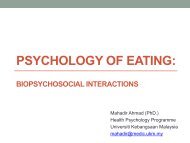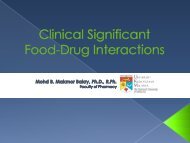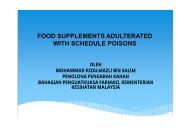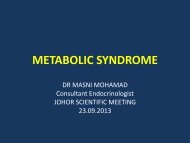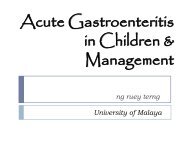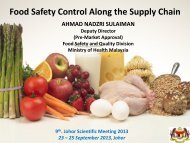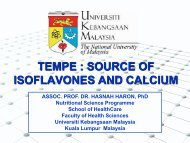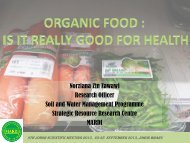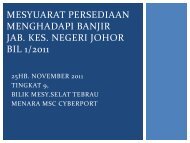OP1 Dr Ranga Rao Ambati : Biological activity of Astaxanthin from ...
OP1 Dr Ranga Rao Ambati : Biological activity of Astaxanthin from ...
OP1 Dr Ranga Rao Ambati : Biological activity of Astaxanthin from ...
Create successful ePaper yourself
Turn your PDF publications into a flip-book with our unique Google optimized e-Paper software.
Why microalgae?‣ More than 25,000 species <strong>of</strong> algae, living every where‣ Algae grown in autotrophic and heterotrophic culture conditions‣ Producing high value metabolites like pigments, fatty acids, lipids,proteins, polysaccharides, minerals and vitamins‣ Used in food, feed, pharmaceutical, nutracetuicals andpigmentation applications
Microalgae species under microscope
Microalgae-used in food, feed and medical applicationsMedical applicationsBioavailability, Toxicity,ImmunesystemNutraceutical applications,Food, Carotenoids,Vitamins,Fatty acids, Minerals,Salmon and Trout feedMicroalgaeProtection <strong>from</strong> UV lightSkin carcinogenesis,Cellular health,Cardivascular,Chronic and acute disease,Anti diabeticAge macular degeneration,Inflammatory, AntioxidantInfections, Antihypertensive,Antiulcer and gastric
Microalgae species with relevance to nutraceutical productsSpecies Product Application areaSpirulina platensisBiomass,PhycocyaninHealth food, cosmeticsChlorella vulgaris Biomass Health food, foodsupplement, feedDunaliella salina Carotenoids, -caroteneHealth food, foodsupplement, feedHaematococcuspluvialisCarotenoids,<strong>Astaxanthin</strong>Health food, feed, colorpharmaceuticalsPorphyridium cruentum PolysaccharidesPharmaceuticals,Nutrition & cosmeticsIsochrysis galbana Fatty acids Animal nutrition
Presentation covers…………‣ Microalgae-Haematococcus‣ Cultivation‣ Isolation <strong>of</strong> carotenoids‣ Quantification <strong>of</strong> carotenoids by HPLC‣ Identification <strong>of</strong> carotenoids by LC-MS‣ Characterization <strong>of</strong> carotenoids by NMR‣ Structure <strong>of</strong> carotenoids‣ <strong>Biological</strong> <strong>activity</strong> <strong>of</strong> carotenoids Antioxidant <strong>activity</strong> Bioavailability Anticancer <strong>activity</strong> in rats Induced cell apoptosis in human cells Hepatoprotrection‣ Results and conclusion
Haematococcus Haematococcus is a green microalga It has two distinct phases in its lifecycle• Motile vegetative growth phaseImmotile encysted stageMotile cell Cyst cells accumulate astaxanthinand appears red H. pluvialis has gained commercialimportance owing to high content <strong>of</strong>astaxanthin 2-3% (w/w)Encysted cell
Cultivation <strong>of</strong> algae
mAUIsolation <strong>of</strong> carotenoids by HPLCmAUOverlaid Spectra2004.50 min 5.10 min 8.62 min 9.02 min 22.17 min 22.75 min200150150100100505000350 400 450 500 550 600 650 700 750 800nm
Quantification <strong>of</strong> carotenoidsCarotenoids (%)Neoxanthin 0.9 ± 0.05Violaxanthin 0.3 ± 0.12<strong>Astaxanthin</strong> 3.8 ± 0.25Lutein 1.4 ± 0.20Zeaxanthin 2.2 ± 0.38β-Cryptoxanthin 2.3 ± 0.25β-carotene 1.7 ± 0.98Un identified peaks 4.5 ± 0.17Astaxathin esters(mono and di-esters)79.58 ± 3.12
Identification <strong>of</strong> carotenoids by LC-MSNo m/z Compound[M] [M+2H-FA 1] +1 MS21 536 [M+H] +1 537 α-carotene, β-carotene2 550.41 [M+H] +1 551.95 echinenone3 568 [M+H] +1 565.86 Lutein, Zeaxanthin4 578 [M] 578 4-ketoalloxanthin5 551.96 [M+H] +1 552 β-cryptoxanthin6 597.04 [M-H 2O] 579 astaxanthin7 602.04 [M+2H] +1 600 Neoxanthin, violaxanthin8 835 579 836 ME C16:09 845 579 846 ME C17:210 847 579 848 ME C17:111 849 579 850 ME C17:012 853 579 852 ME C18:513 855 579 854 ME C18:414 857 579 856 ME C18:315 859 579 858 ME C18:216 861 579 859 ME C18:117 1072 579 1071 DE C16:0/C16:018 1096 579 1095 DE C16:0/C18:219 1120 579 1119 DE C18:1/C 18:320 1122 579 1121 DE C18:1/C18:221 1124 579 1123 DE C18:1/C 18:1Xanthophyll's andother carotenoidsAstxanthinestersJohor Scientific Meeting-2013
Characterization <strong>of</strong> carotenoids by NMRAX AXMEs AXDEsPosition H mult c H mult c H mult c( J in Hz)(ppm) ( J in Hz) (ppm) ( J in Hz) (ppm)1 4.32 (m, 1-OH), 4.33 (m, 1H) 68.88 5.1 71.64 5.1 (-OH, H) 71.641’ 4.35,4.36 (OH) 68.88 5.10 68.89 5.1 (-OH, H) 71.642 1.85 (m, 1H) 61.85 1.37 61.78 1.37 (m, H) 61.792` 1.83 61.85 1.36 61.78 1.36 (m, H) 61.793 -- 45.14 -- 42.41 -- 37.223` -- 45.14 -- 42.41 -- 37.174 1.23 68.76 1.26 68.81 1.26 68.814` 1.32 68.76 1.31 68.55 1.31 68.505 -- 127.77 -- 127.79 -- 127.755` -- 127.77 -- 127.79 -- 127.756 -- 200.09 -- 202.21 -- 193.496` -- 200.09 -- 196.11 -- 193.177 6.48 1H, m) 126.52 5.40 126.80 5.40(1H, m) 126.807` 6.46 (1H, m) 125.91 5.39 126.80 5.40(1H, m) 126.808 6.45( 1H, m) 142.00 5.38 131.62 5.38 131.638` 6.43 (1H, m) 141.87 5.37 131.62 5.37 131.639 -- 133.10 -- 143.32 -- 133.389` -- 133.22 -- 142.65 -- 133.3810 6.21 131.80 5.38 127.38 5.28 127.4410` 6.25 131.13 5.37 127.38 5.33 127.4411 6.70 129.00 5.35 127.44 5.40 127.5811` 6.70 (1H, m) 129.40 5.35 127.44 5.40 127.5812 6.26 (j=13Hz, 6Hz) 134.85 5.33 129.88 5.38 129.8912` 6.23 (dd, J=13Hz/6Hz) 134.25 5.33 129.67 5.37 129.8913 -- -- -- -- -- ---13` -- -- -- -- -- --14 5.31 131.80 5.38 127.28 5.40 127.2914` 5.35 131.13 5.37Johor Scientific Meeting-2013127.75 5.40 127.29
15 6.25 129.40 6.2 127.44 5.38 127.4415` 6.21 129.00 6.2 127.44 5.37 127.4416 2.02 20.01 2.00 20.22 2.00 20.2216` 2.01 20.32 2.01 20.85 2.01 20.2217 1.31 (3H, m) 25.83 1.21 26.87 1.27(3H, m) 26.3717` 1.31 (3H,m) 25.83 1.21 26.87 1.27 (3H, m) 26.3718 1.32 (3H, m) 25.83 1.20 26.70 1.29(3H, m) 26.7018` 1.32 (3H,m) 25.83 1.20 26.70 1.29 (3H, m) 26.7019 1.96 (3H, m) 13.83 2.02 13.76 2.04 (3H, m) 13.7619` 1.97 (3H,m) 13.64 2.03 13.76 2.04 (3H, m) 13.7620 1.99 (3H, m) 12.25 2.06 13.76 2.05 (3H, m) 13.7620` 1.99 (3H,m) 12.49 2.08 13.76 2.05 (3H, m) 13.7621 36.01 -- 37.2221` -- -- -- 37.2222 2.0 29.36 2.331 29.3722` -- -- 2.331 29.3723 1.39 29.01 1.384 29.0223` -- -- 1.371 29.0224 2.02 29.16 2.006 29.1724` -- -- 2.019 29.1725 1.48 28.83 1.48 28.8425` -- -- 1.48 28.8426 1.31 28.78 1.316 28.3926` -- -- 1.357 28.3927 2.00 28.38 2.006 28.8427` -- -- 2.006 28.8428 2.00 129.67 2.019 29.0228` -- -- 2.019 29.0229 2.00 129.88 2.031 129.8929` -- -- 2.031 129.8930 2.03 129.67 2.043 129.8530` -- -- 2.043 129.8531 2.00 29.36 2.071 30.1531` -- -- 2.071 30.1532 1.20 29.86 1.270 31.2032` -- -- 1.270 31.2033 1.21 30.01 1.295 31.4633` -- -- 1.295 31.4634 1.26 29.36 1.270 31.5934` -- 1.270 31.5935 1.31 29.16 1.316 29.3735` -- -- 1.316 29.3736 1.35 31.59 1.357 31.5936` --- -- 1.357 31.5937 1.61 20.22 1.625 20.2237` --- --- 1.625 20.2238 0.98 13.92 0.991 13.9238` -- -- 0.976 13.92
OCCH 3CH 3H 3CH 3CH 3CH 3C H 3OHHOOCH 3CH 3Free astaxanthinCH 3H 3C CH 3H 3COH 3C CH 3OOCRHOOH 3C CH 3CH 3CH 3astaxanthin monoesterCH 3H 3C CH 3H COCH 3CH 33OOCRRCOOOCH 3CH 3astaxanthin diesterCH 3H 3C CH 3Structure <strong>of</strong> carotenoids -<strong>Astaxanthin</strong>, mono-ester and diester- forms<strong>of</strong> <strong>Astaxanthin</strong> R= saturated or unsaturated alkylchains)
<strong>Biological</strong> <strong>activity</strong> <strong>of</strong>carotenoids
Mechanism <strong>of</strong> astaxanthin‣ <strong>Astaxanthin</strong> molecule isexposed both in andouside <strong>of</strong> the cellmembrane‣ β-carotene and vitaminC reside inside andoutside the lipid bilayermembrane‣ No other antioxidantposses the threecharacteristic at once
Antioxidant <strong>activity</strong>Antioxidant <strong>activity</strong> <strong>of</strong> astaxanthin on (A) -CLAMS method, and (B) Hydroxyl radicalscavenging.Anti lipid peroxidation <strong>of</strong> astaxanthin on (A)Kidney, (B) Brain, and (C) Liver.
Hepatoprotective <strong>activity</strong>GroupsCatalase(U/mg protein)Glutathioneperoxidase(U/mgprotein)Superoxidedismutase(U/mgprotein)% Anti-lipidperoxidaseGlutathione(nmol/mgprotein)NormalToxinASX100*ASX250*ASXEs 100*ASXEs250*SASX100*457.23 ± 6.98 10.12 ± 1.42 20.81 ± 1.75 22.45 ± 2.61 11.23 ± 1.15312.51 ± 10.37 6.56 ± 1.74 10.05 ± 2.38 53.78 ± 3.80 4.25 ± 0.93428 ± 12. 61** 11.98 ± 4.63** 12.13 ± 2.66** 18.91 ± 2.13** 8.16 ± 1.84**543.01 ± 9.61** 15.98 ± 2.30** 15.02 ± 1.73** 26.46 ± 1.09** 10.47 ± 1.06**623. 84 ± 8.25*** 21.79 ± 3.06*** 26.13 ± 3.67*** 21.81 ± 2.74*** 15.03 ± 1.09***745.28 ± 6.05*** 23.65 ± 1.65*** 32.98 ± 4.01*** 10.33 ± 1.12*** 18.69 ± 2.78**561.31 ± 11.82** 11.24 ± 2.38** 16.81 ± 3.22** 27. 58 ± 2.91** 13.52 ± 2.13**
<strong>Astaxanthin</strong>(nmol/g or ml)BioavailabilityTime in(h)Catalase(U/mg protein)Superoxidedismutase(U/mgprotein)Peroxidase(U/mg protein)Plasma0 106.85 ± 3.59 a 7.57 ± 1.21 c 7.35 ± 1.55 c2 250.10 ± 12.03 b 12.12 ± 3.25 a 15.05 ± 0.92 a4 243.58 ± 8.03 b 11.14 ± 6.32 a 12.86 ± 0.61 b6 199.23 ± 5.47 c 10.01 ± 0.54 a 10.51 ± 0.61 b10009 178.55 ± 15.42 c 9.09 ± 2.51 b 9.95 ± 1.14 bLiver0 251.52 ± 2.10 c 10.34 ± 0.54 c 7.44 ± 2.64 c5002 336.67± 4.51 b 13.80 ± 4.47 b 10.11±1.47c0Plasma Liver EyeRat tissues4 383.08 ± 1.81 a 17.19 ± 3.87 a 16.28 ± 2.25 a6 374.45 ± 4.34 a 16.29 ± 1.21 a 14.63 ± 3.99 a9 366.44 ± 4.34 a 15.65 ± 0.85 a 11.32 ± 2.37 b<strong>Astaxanthin</strong> bioavailability after a single or repeated dose <strong>of</strong> H. pluvialis fed ratsas source <strong>of</strong> astaxanthin
Inhibition <strong>of</strong> cancer in rats, induced cell apoptosisTumor ItensityPhotographs <strong>of</strong> rat skin tumors and histopathologyInduced cell apoptosis by<strong>Astaxanthin</strong>
Results AX and AXEs were found to be 3% and 80% in Haematococcus followed by other carotenoids A total 13 AXEs were identified based on mass spectra data. Further, AX and AXEs werestructurally confirmed by 13 C NMR, 1 H NMR, HSQC 2D, NOESY 2D and COSY 2D NMRspectroscopy The Haematococcus extract exhibited 80-85% antioxidant <strong>activity</strong> in various methods <strong>Astaxanthin</strong> in rats showed peak levels in plasma, liver, and eyes at 2, 4, and 6 h, respectively The antioxidant enzymes levels were significantly high in plasma and liver The AXEs at the concentration <strong>of</strong> 250 µg/kg b.w showed maximum hepatoprotective <strong>activity</strong>against CCl 4 induced hepatic damage Further confirmed that astaxanthin & its esters showed potential anti-cancer <strong>activity</strong> in UV-DMBA induced skin cancer rats, induced cell apoptosis in human glioma cells This study implies that microalgae can be a good source <strong>of</strong> carotenoids <strong>of</strong> high biological<strong>activity</strong> and nutraceutical value
Conclusion‣ Based on the current observations that astaxanthinenhances bioavailability, antioxidant <strong>activity</strong>, anticancer‣ Further theses molecules can be used for foodproperty and hepatoprotection in ratssupplements, pharmaceuticals and nutraceuticalsapplications
Research TeamAcknowledgments Pr<strong>of</strong>. <strong>Dr</strong>. G. A. Ravishankar, Vice-president, DSI, R&D Life Sciences, Bangalore, India <strong>Dr</strong>. R. Sarada, Senior Scientist, CFTRI, Mysore, India <strong>Dr</strong>. Baskaran V, Senior Scientist, CFTRI, Mysore, India <strong>Dr</strong>. Shylaja M Darmesh, Senior Scientist, CFTRI, Mysore, India <strong>Dr</strong>. Udaya Sankar, Scientist & Head, Food Engineering, CFTRI, Mysore, India Pr<strong>of</strong>. <strong>Dr</strong>. Phang Siew Moi, Director, IOES, University <strong>of</strong> Malaya, MalaysiaFunding Support‣ DST, DBT, ICMR, CSIR, Govt <strong>of</strong> India‣ University <strong>of</strong> Malaya Research Grant (UMRG), University <strong>of</strong> Malaya‣ Thanks to Organizers <strong>of</strong> the Symposium



